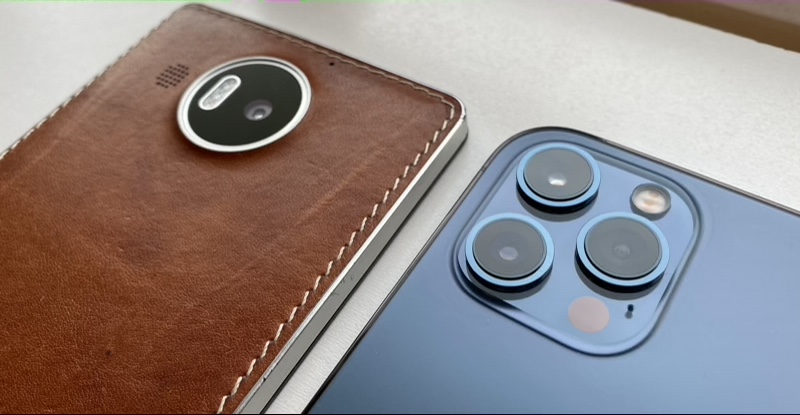
Lumia 950 XL and iPhone 12 Pro Max cameras
| Lumia 950 XL (2015) | iPhone 12 Pro Max (2020) |
|
Dedicated two-stage shutter button/launch key 20 MP (oversampled to 8MP here), f/1.9, 1/2.4", PDAF, OIS |
12 MP, f/1.6, 1/1.9" (estimated), dual pixel PDAF, sensor-shift OIS |
Because I want to show three crops for each test scene, I can't use the A-B comparator. So I'll put them one above the other for easy comparison.
Test 1: Sunny scene
A bright red berry tree in low but full-on winter sunshine. Here's the overall scene:
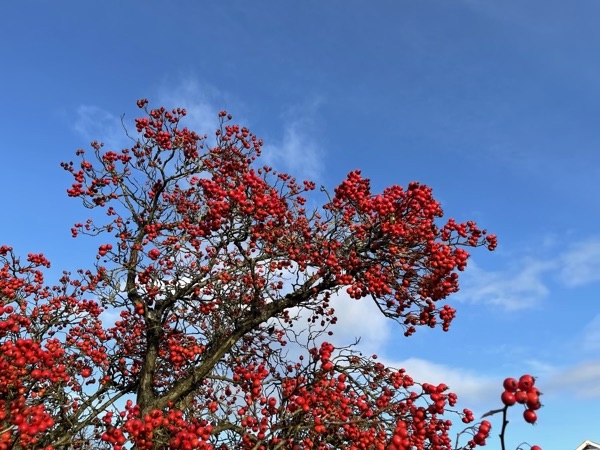
And here are 1:1 crops from (click the links for the full resolution files, for your own analysis) the Lumia 950 XL, the iPhone 12 Pro Max's default HEIC/JPG image processing, and then the same phone but captured in the 'high quality' ProRAW mode (here simply exported as JPG for you):



A strong start for the Lumia - its photo is perhaps a little too 'golden', a common Lumia sunshine trait, but the berries look perfect. And yes, the sky really is bluer in Lumia land! The iPhone's default processing works well here, even the edge enhancement doesn't seem totally overdone. While the ProRAW version is a little more muted - though the caveat would be that as a RAW variant, it would be trivial to dial up colour in any photo editor without degrading quality at all. But, viewed as-is, we have a narrow win for the Lumia 950 XL.
Scores: Lumia 950 XL: 9 pts; iPhone 12 Pro Max default: 8 pts; iPhone 12 Pro Max ProRAW capture: 8 pts
Test 2: Sunny scene, zoomed
The same berry tree but zoomed by 2.5 times. Here are 1:1 crops from (click the links for the full resolution files, for your own analysis) the Lumia 950 XL, the iPhone 12 Pro Max's default HEIC/JPG image processing, and then the same phone but captured in the 'high quality' ProRAW mode (here simply exported as JPG for you):



With no telephoto lens and limited PureView lossless zoom, the Lumia 950 XL struggles here and you can see the telltale artefacts when looking at the pixel level here. On the iPhone 12 Pro Max, the default processing is again really impressive - yes, I keep complaining about its lack of purity, but that's mainly in low light, as we'll see below. In bright light, as here, results are terrific - obviously enhanced, but tastefully so. The ProRAW version could again be improved in an editing package and it nicely neutral, but I have to give the win to the default algorithms here.
Scores: Lumia 950 XL: 6 pts; iPhone 12 Pro Max default: 10 pts; iPhone 12 Pro Max ProRAW capture: 9 pts
Test 3: HDR landscape
A parked lorry 100m away against a sunset skyline - great opportunity to test HDR and captured detail. Here's the overall scene:
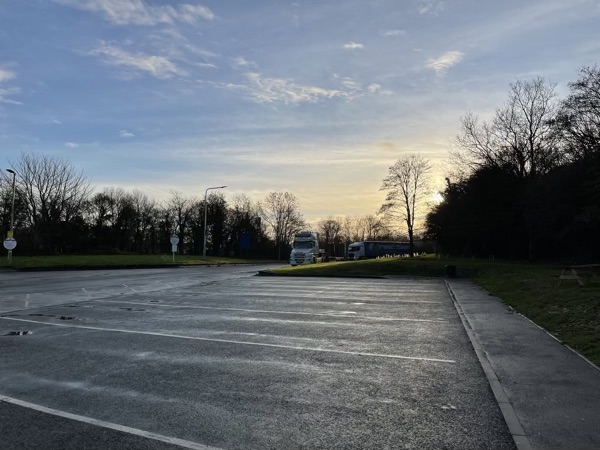
And here are 1:1 crops from (click the links for the full resolution files, for your own analysis) the Lumia 950 XL, the iPhone 12 Pro Max's default HEIC/JPG image processing, and then the same phone but captured in the 'high quality' ProRAW mode (here simply exported as JPG for you):



Interestingly, the Lumia 950 XL (from 2015) did slightly better, I'd argue at handling the HDR, as there's more colour in the sky and more detail in the raised ramps. It's also the purest and most natural photo here, with more detail in the trees, and I'd argue that the Lumia shot looks most 'real', at least at the pixel level. The iPhone's default and ProRAW versions aren't that different, with just a cleaning up of text and panels of the same colour in the default processed version. And the iPhone manages to 'lose' small branches from the treeline in both photos.
Scores: Lumia 950 XL: 10 pts; iPhone 12 Pro Max default: 8 pts; iPhone 12 Pro Max ProRAW capture: 8 pts
Test 4: HDR zoomed
The same scene but zooming in to around 2.5x on each phone camera. Here are 1:1 crops from (click the links for the full resolution files, for your own analysis) the Lumia 950 XL, the iPhone 12 Pro Max's default HEIC/JPG image processing, and then the same phone but captured in the 'high quality' ProRAW mode (here simply exported as JPG for you):



The usual deal with zoom on the Lumia, the photo looks pretty bad close-up, though admittedly if you look at the photo as-is on a phone screen then it looks fine. But here we see the usual lossy zoom artefacts. Of the two iPhone 12 Pro Max shots, you can see the way the default processing tries to clean up areas of colour and enhance edges and - particularly - text. I'd agree that the default processing's shot looks clearer, but it's artificial clarity. Still, I can't pick my winner of the two - one looks natural and PureView-esque (even the trees don't look too bad), the other has a definite wow factor.
To be fair, I've zoomed at exactly the factor of the 12 Pro Max's telephoto lens - if I'd specified 2x zoom then the Lumia's shot would have been similar or even better. But I don't think 2.5x is an outrageous zoom factor and it's an easy one to use in day to day life.
Scores: Lumia 950 XL: 7 pts; iPhone 12 Pro Max default: 9 pts; iPhone 12 Pro Max ProRAW capture: 9 pts
Test 5: Software zoom only
A shot of a statue, zoomed by 2x to test software zoom (i.e. under the 2.5x zoom telephoto limit on the iPhone. Just because. There will be situations where zooming to 2x makes for perfect framing and you don't want to go further in. So let's test that. Here's the overall scene:

And here are 1:1 crops from (click the links for the full resolution files, for your own analysis) the Lumia 950 XL, the iPhone 12 Pro Max's default HEIC/JPG image processing, and then the same phone but captured in the 'high quality' ProRAW mode (here simply exported as JPG for you):



All three are slightly ugly when seen at 1:1 here! Which goes to prove that you should stay away from software zoom if possible, whatever phone you've got! The details are crisper on the Lumia because it has 1.5x lossless zoom into the sensor and then 0.5x lossy zoom, while the iPhone has to do the full 2x zoom in software on its main lens. But the Lumia also blows out the highlights, here in full sun, while the iPhone's HDR routines handle this better, even on the ProRAW shot (remember that ProRAW is saved after the HDR and other multi-frame combination). So all a bit unsatisfactory and honours even.
Scores: Lumia 950 XL: 6 pts; iPhone 12 Pro Max default: 6 pts; iPhone 12 Pro Max ProRAW capture: 6 pts
Test 6: Landscape textures and edges
So modern processing likes edges? Let's give it loads of edges, here showing a house scene in sunlight. Bricks, windows, the lot. Here's the overall scene:
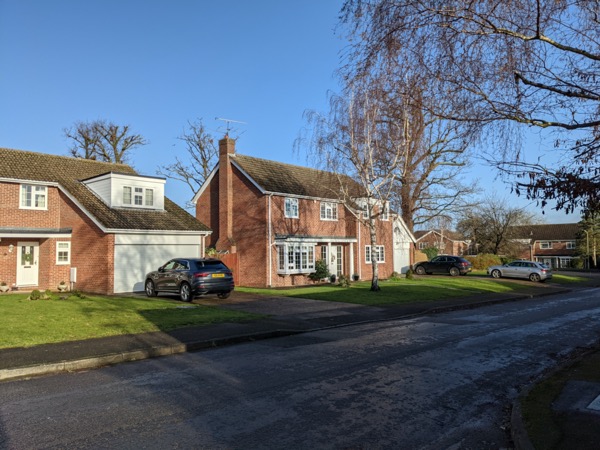
And here are 1:1 crops from (click the links for the full resolution files, for your own analysis) the Lumia 950 XL, the iPhone 12 Pro Max's default HEIC/JPG image processing, and then the same phone but captured in the 'high quality' ProRAW mode (here simply exported as JPG for you):



This surprised me - the iPhone ProRAW shot is closer to the default shot than to the more natural Lumia's. Mind you, considering the amount of detail in the scene, all three photos are top notch. As you might expect in great light. To my eyes the Lumia 950 XL's photo has more natural detail, but then it's also slightly yellowed - see the house door, for example. It still wins over the iPhone's processed images, but only by a whisker.
All a bit confusing though - the ProRAW shot is supposed to be saved before edge enhancement routines, yet here it's clearly got the same processing as the default. So maybe what happens is very much light-dependent?
Scores: Lumia 950 XL: 9 pts; iPhone 12 Pro Max default: 8 pts; iPhone 12 Pro Max ProRAW capture: 8 pts
Test 7: Low light zoom
A Santa and snowman LED display. Here's the overall scene, already zoomed by about 4x on the Lumia (I won't show an unzoomed shot as there's private data in the scene):

And here are scaled crops from (click the links for the full resolution files, for your own analysis) zoomed images from the Lumia 950 XL, the iPhone 12 Pro Max's default HEIC/JPG image processing, and then the same phone but captured in the 'high quality' ProRAW mode (here simply exported as JPG for you):



By default the Lumia 950 XL just wouldn't focus on the Santa sign - low light PDAF is rarely successful. But manual focus managed the shot above, which doesn't look too bad. Until you see what the iPhone 12 Pro Max can do - the Santa Stop Here part is actually red, not fiery orange, and the iPhone nailed this first time, with focus. Thanks partly to the 2.5x telephoto lens and partly the better interpolative software zoom - the shot above was at 4.5x zoom on the iPhone.
Again the iPhone's default processing (brightening, sharpening, edge enhancing) works pretty well here. Yes, the ProRAW show is more natural, as me eyes saw the scene, but the processing does add an extra punch with no major downsides for this subject.
Scores: Lumia 950 XL: 6 pts; iPhone 12 Pro Max default: 9 pts; iPhone 12 Pro Max ProRAW capture: 9 pts
Test 8: Dusky suburbia
My standard suburbia landscape, this time shot at dusk - poor light but still some colour, plus Christmas lights. Here's the overall scene:

And here are 1:1 crops from (click the links for the full resolution files, for your own analysis) the Lumia 950 XL, the iPhone 12 Pro Max's default HEIC/JPG image processing, and then the same phone but captured in the 'high quality' ProRAW mode (here simply exported as JPG for you):



The Lumia 950 XL's shot looks super natural, but also a bit indistinct by modern standards (better sensors, more processor horse power etc.), while the iPhone's default processing goes gung ho in low light to reduce noise and then to sharpen and edge enhance. And the results are ugly, down at the pixel level here. You can see what I mean above. However, the ProRAW capture from the iPhone is a whole different story. Wonderful purity, low noise, no artificial edges at all. The new gold standard in low light phone photography?
Scores: Lumia 950 XL: 8 pts; iPhone 12 Pro Max default: 7 pts; iPhone 12 Pro Max ProRAW capture: 10 pts
Test 9: Night porch
A Christmassy porch at dead of night. Here's the overall scene:
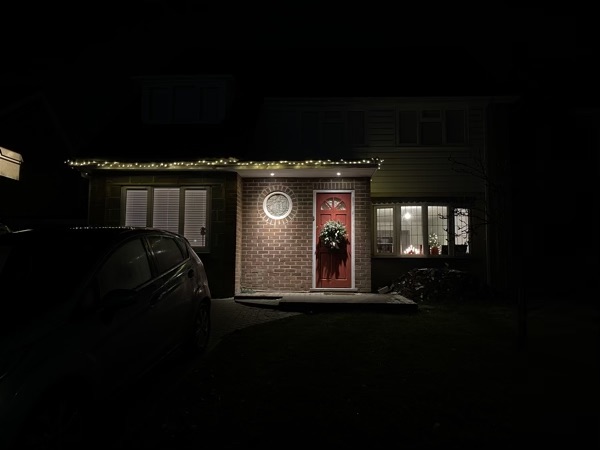
And here are 1:1 crops from (click the links for the full resolution files, for your own analysis) the Lumia 950 XL, the iPhone 12 Pro Max's default HEIC/JPG image processing, and then the same phone but captured in the 'high quality' ProRAW mode (here simply exported as JPG for you):



I'm not going to criticise the Lumia for colour balance here because the real colour to my eyes was halfway between its rendition and the iPhone's, which appears too cold here. But as with the dusk scene, in low light the iPhone's default processing can often go way over the top. Here the details in the circular mural are exagerated, 'texture' of the red door is brought out where there should be none, plus the door decoration looks too artificial. But again the ProRAW capture does really well, with restrained, natural HDR and is the winner here by some way.
Scores: Lumia 950 XL: 7 pts; iPhone 12 Pro Max default: 8 pts; iPhone 12 Pro Max ProRAW capture: 10 pts
Verdict
Adding up the scores throughout gives us:
- Apple iPhone 12 Pro Max ProRAW: 77 pts/90
- Apple iPhone 12 Pro Max default processing: 73 pts
- Lumia 950 XL: 68 pts
The pros and cons, winners and losers varied across the various scenes, so as usual I'm going to preface any conclusion with 'your mileage may vary'. How you score various camera phones and their image processing options will vary hugely according to what you want to snap.
My gut feel was that the ProRAW captures would blow the others away and indeed this new 'smart but natural' solution by Apple did win out, but not by a landslide. Having taken a lot of shots (far more than in my articles here) on the system, I'd say that there's little benefit day to day in toggling into capturing in ProRAW on the iPhone 12 Pro series - save it for low light and when there are serious dynamic range problems to solve. The rest of the time, the default processing on the iPhone 12 Pro is just fine. It's worth saying that I believe Apple has (thankfully) toned its edge enhancement down in most light conditions, possibly as part of the iOS 14.3 update - it's not as egregious now.
Meanwhile the venerable (2015) Lumia 950 XL just about keeps up. I still love the natural processing generally, but the slow and unreliable focus in low light, the yellow cast in sunny conditions, the lack of any telephoto (or wide angle), and the limitations in dynamic range, all start to grate a little as we head into 2021. Maybe the iPhone 12 Pro Max ProRAW should be my new 'benchmark' in mobile imaging? That would seem appropriate as the 'All About' sites head into a new era in 2021 (watch this space).
